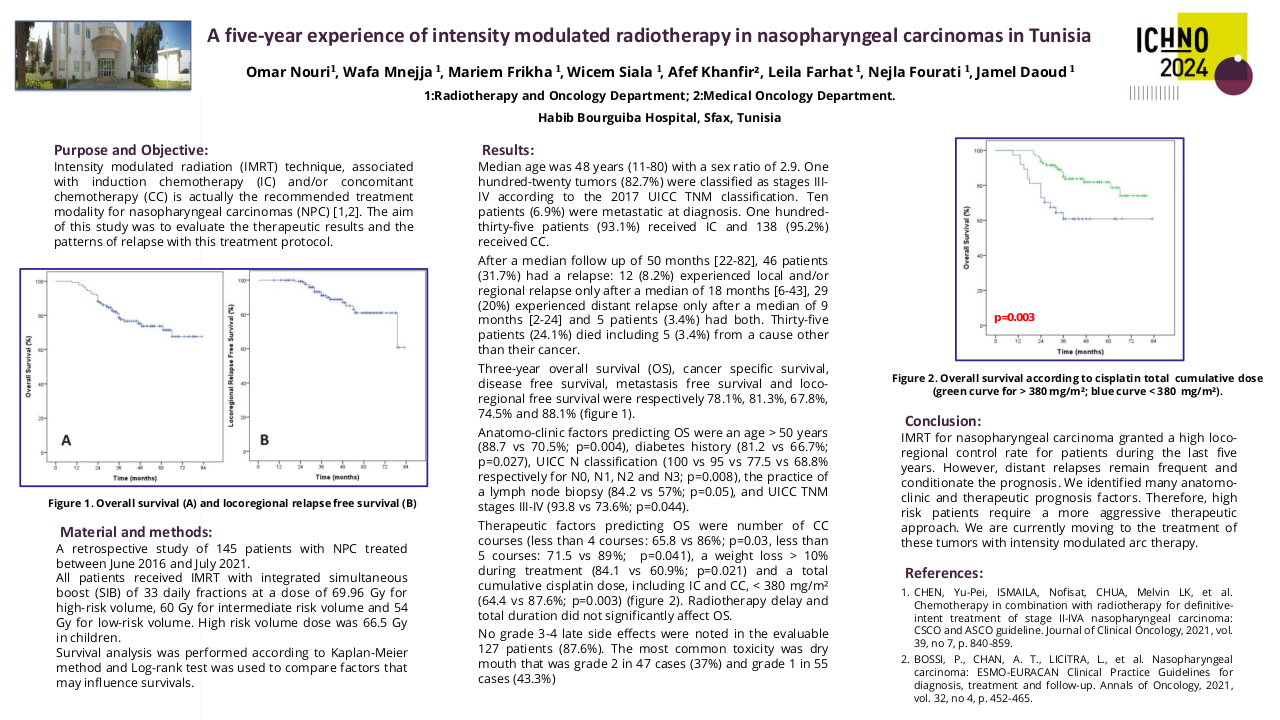Disease characteristics, treatment and two-years overall survival for non-metastatic nasopharyngeal carcinoma: real world data from the national oncology institute, Morocco.
Purpose/Objective
Nasopharyngeal cancer is one of the most common aero-digestive cancers in Morocco. His treatment is essentially based on radiotherapy combined with chemotherapy (1,2).
In addition to investigating disease characteristics and pattern of treatment, the main objective of this study is to evaluate locoregional, distant control and 2 years overall survival in patients with non-metastatic nasopharyngeal carcinoma.
Material/Methods
This is a retrospective study involving 254 patients collected in the National Institute of Oncology (INO) in Morocco. The study period extends from January 1, 2018 to December 31, 2021.
For this study, we included patients suffering from nasopharyngeal cancer based on histological and radiological evidence.jWe collected data through hospital records and during patient follow-up consultations.
The statistical analysis was carried out using SPSS software version 18.0.
Results
During the four years of the study, we identified a total of 254 patients. The series finds 154 men and 100 women. Sex-ratio was 1,54. The median age was 47,07 years with extremes of 12 and 86 years. Undifferenciated Carcinoma of Nasopharyngeal type (UCNT) was the most represented histological type, i.e 82,22 % of the population. Squamous cell carcinoma was found in 17,78%.
We had 5 stages I patients, 35 stages II patients, 81 stage III patients, 133 stage IVa patients.
In the majority of our patients therapeutic approach was based on concomitant chemoradiation (205 patients); 157 of these patients underwent neoadjuvant chemotherapy. Doxorubicin combined with cisplatin was the most frequently used protocol (35.66%) as neoadjuvant chemotherapy.
All patients received weekly cisplatin during concomitant chemoradiation.
Overall survival at 2 years was 84,56% for stage I and II patients and 62,03% for stage III and IVA patients.
Conclusion
In view of our data and those of the literature, cisplatin-based chemotherapy and head and neck radiotherapy at curative doses, as well as neoadjuvant chemotherapy with concomitant radio-chemotherapy, allowed local control of overall survival at two years. However, certain toxicities can interfere with the successful completion of treatment.Future trials should therefore offer less toxic molecules for therapeutic purposes.
(1): Blanchard P,Lee A,Marguet S et al.MAC-NPC Collaborative group. Chemotherapy and Radiotherapy in nasopharyngeal carcinoma:an update of the MAC-NPC méta-analyse. Lancet Oncologies 2015;114(suppl):6-7.(2): Yoshizaki T, Kondo S, Murono S et al. Progress and controverse for the rôle of chemothérapy in nasopharyngeal carcinoma. Jpn J Clin Oncologies 2015,45(3)244-47.






